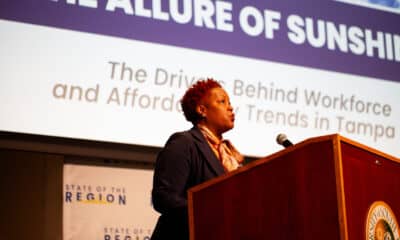Silver linings and sobering statistics emerge in Tampa Bay Partnership State of the Region
Record high unemployment, declines in homes sales and a murky prognosis for air travel are among the impacts the Tampa Bay region has felt from the COVID-19 pandemic.
There also could be business opportunities emerging from the crisis, Rick Homans, president and CEO of the Tampa Bay Partnership, said during the Partnership’s State of the Region webinar Wednesday.
Among those opportunities are technologies that have come to the forefront during the pandemic, said Moez Limayem, dean of the University of South Florida Muma College of Business.
Online education and online training are booming, and cybersecurity is increasingly important with a remote workforce. Contact tracing and the big data and predictive modeling behind it could be a growth area as well.
“There’s the whole area of digital transformation,” Limayem said. “I read an article where the author asked, should the CEO or the CIO lead the digital transformation in crisis like COVID-19. My answer is neither one. The digital transformation was led by COVID-19. That’s what really pushed us to do the things in a digital format, that whole area of rethinking the processes, rethinking products and services, while practicing social distancing and remote work is really important … I’m very optimistic. There are so many people now in the Tampa Bay area working on this and I think there are many opportunities.”
On a more sobering note, the pandemic has taken a serious public health toll, with 391 deaths in the eight-county Tampa Bay region as of May 26, said Dave Sobush, director of policy and research for the Partnership.
A partisan divide has emerged locally over preventative measures to slow the spread of the virus, said Joseph St. Germain, president of Downs & St. Germain Research, which is conducting bi-weekly consumer sentiment surveys for the Partnership.
The Partnership has launched a regional dashboard tracking overall cases, testing and hospital capacity.
“What we do is track the numbers and make sure that should hospitalizations and deaths begin to increase, that we are poised as a region and that our hospitals working together as a system are able to accommodate a wave of patients that need emergency measures to save their lives,” Sobush said.
Here are some other key economic benchmarks from the webinar:
• The April unemployment rate in the region was 13.34 percent, the highest monthly rate on record, with unemployment at 13.9 percent in Pinellas County and 12.04 percent in Hillsborough County. Low-wage service occupations were hit the hardest.
“As the economy re-opened, many jobs have seen an uptick in hiring but have a long way to go to pre-pandemic levels,” Sobush said.
• Passenger traffic was down 96 percent at the three airports in the region, from 2.4 million passengers in April 2019 to 101,500 in April 2020. The federal CARES Act provided short-term-relief to airports, and some expert forecast a gradual upswing in passenger traffic later this year, but the dip in flyers has repercussions.
“Losing passengers means our airports lose important revenue that comes from passenger facility charges, car rental fees, parking and concessions. In the case of Tampa International Airport, those fees represent half of its revenue, and that revenue pays off bonds for an expansion project along with other operating expenses,” Sobush said.
Related: Tampa-St. Pete is a top destination as passengers start to get back on airplanes
• Residential real estate sales are a good news/bad news story.
“The bad news is that the volume and total value of home sales has dropped more than 45 percent year over year. The good news is that the prices of the homes that have sold have held their own,” Sobush said. “Sellers are waiting for the storm clouds to pass and they’re not rushing into a fire sale. Steady values mean that property appraisals may hold firm and that’s good news for state and local governments that rely on property taxes.”
Food insecurity has emerged as a key issue during the pandemic, said Jessica Muroff, president and CEO of United Way Suncoast, which collaborates with the Tampa Bay Partnership on the State of the Region report. The nonprofit launched a response and recovery fund that has since raised $1.6 million and has allocated more than $1.4 million in grants to support 70 agencies serving more than 900,000 individuals in the region.
Another collaborator on the State of the Region report, the Community Foundation of Tampa Bay, designed a nonprofit needs list, a unique COVID philanthropic response that complements other efforts in the area, said Marlene Spalten, president and CEO of the foundation. The list creates an opportunity to nonprofits to quickly and publicly share their most urgent needs, and checks go out immediately, she said. So far, the organization has provided about $2 million in 172 different grants.





